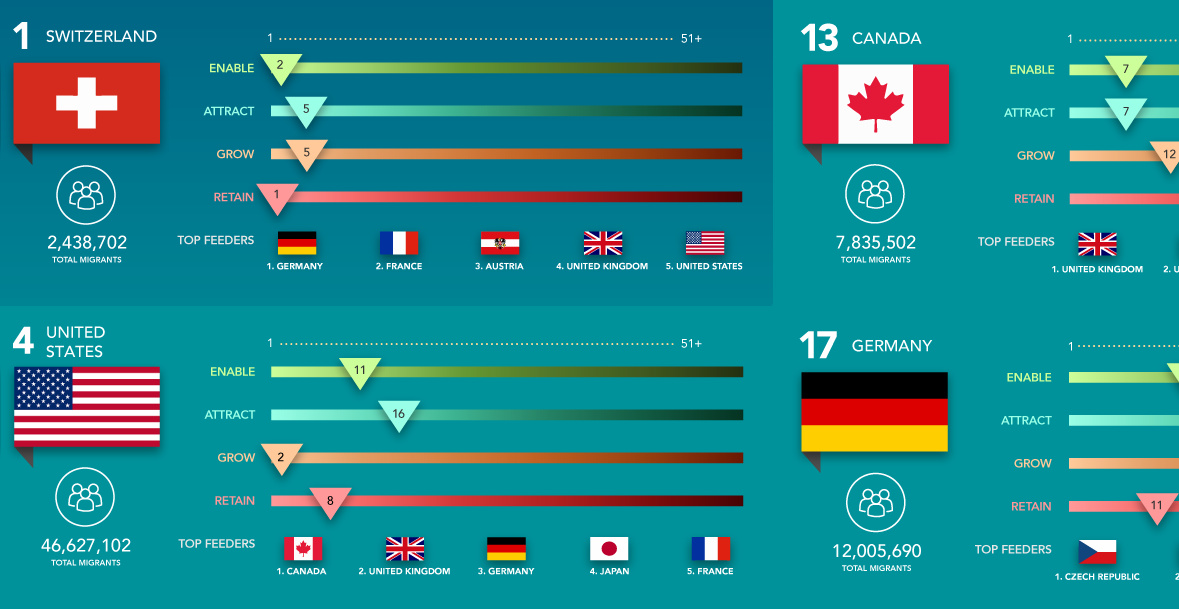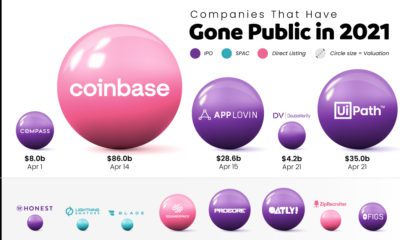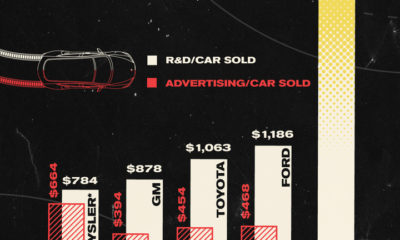Whether we’re talking about a giant like Google that is constantly searching to add world-class engineers or we’re talking about a startup that needs a visionary to shape products of the future, innovative companies require access to high-skilled workers to stay ahead of their competition.
The Global Search for Talent
There’s no doubt that top companies will go out of their way to bring in highly-skilled workers, even if they must look internationally to find the best of the best. However, part of this recruitment process is not necessarily under their control. The reality is that countries themselves have different policies that affect how easy it is to attract people, educate and develop them, and retain the best workers – and these factors can either empower or undermine talent recruitment efforts. Today’s infographic comes from KDM Engineering, and it breaks down the top 25 countries in attracting high-skilled workers.
If attracting the best people isn’t hard enough, there is another factor that can complicate things: the best people are sometimes not found locally or even nationally. For top companies, recruitment is a global game – and it’s partially driven by the policies of governments as well as the quality of life within their countries’ borders.
Top Countries for Attracting High-Skilled Workers
Using data from the United Nations and the Global Talent Competitive Index, here are the top 10 countries that are the best at attracting and retaining highly-skilled workers. They are ordered by overall rank, but their sub-category ranks are also displayed: The subcategory ranks are defined as follows:
Enable: Status of regulatory and market landscapes in country Attract: Ability to attract companies and people with needed competencies Grow: Ability to offer high-quality education, apprenticeships, and training Retain: Indicates quality of life in country
According to the data, Switzerland (#1) and Singapore (#2) are the two best countries for attaining and keeping high-skilled workers. While the regulatory environments in both of these countries are well-known by reputation, perhaps what’s more surprising is that Singapore scores the #1 rank in the “Attract” subcategory, while Switzerland is the #1 country for retaining talent based on quality of life. Another data point that stands out? The United States has a higher total migrant population (46.6 million) than all of the countries on the top 10 list combined. Not surprisingly, the massive U.S. economy also has a high ranking in the “Grow” category, which represents available opportunities to bring high-skilled workers to the next level through education and training. on But fast forward to the end of last week, and SVB was shuttered by regulators after a panic-induced bank run. So, how exactly did this happen? We dig in below.
Road to a Bank Run
SVB and its customers generally thrived during the low interest rate era, but as rates rose, SVB found itself more exposed to risk than a typical bank. Even so, at the end of 2022, the bank’s balance sheet showed no cause for alarm.
As well, the bank was viewed positively in a number of places. Most Wall Street analyst ratings were overwhelmingly positive on the bank’s stock, and Forbes had just added the bank to its Financial All-Stars list. Outward signs of trouble emerged on Wednesday, March 8th, when SVB surprised investors with news that the bank needed to raise more than $2 billion to shore up its balance sheet. The reaction from prominent venture capitalists was not positive, with Coatue Management, Union Square Ventures, and Peter Thiel’s Founders Fund moving to limit exposure to the 40-year-old bank. The influence of these firms is believed to have added fuel to the fire, and a bank run ensued. Also influencing decision making was the fact that SVB had the highest percentage of uninsured domestic deposits of all big banks. These totaled nearly $152 billion, or about 97% of all deposits. By the end of the day, customers had tried to withdraw $42 billion in deposits.
What Triggered the SVB Collapse?
While the collapse of SVB took place over the course of 44 hours, its roots trace back to the early pandemic years. In 2021, U.S. venture capital-backed companies raised a record $330 billion—double the amount seen in 2020. At the time, interest rates were at rock-bottom levels to help buoy the economy. Matt Levine sums up the situation well: “When interest rates are low everywhere, a dollar in 20 years is about as good as a dollar today, so a startup whose business model is “we will lose money for a decade building artificial intelligence, and then rake in lots of money in the far future” sounds pretty good. When interest rates are higher, a dollar today is better than a dollar tomorrow, so investors want cash flows. When interest rates were low for a long time, and suddenly become high, all the money that was rushing to your customers is suddenly cut off.” Source: Pitchbook Why is this important? During this time, SVB received billions of dollars from these venture-backed clients. In one year alone, their deposits increased 100%. They took these funds and invested them in longer-term bonds. As a result, this created a dangerous trap as the company expected rates would remain low. During this time, SVB invested in bonds at the top of the market. As interest rates rose higher and bond prices declined, SVB started taking major losses on their long-term bond holdings.
Losses Fueling a Liquidity Crunch
When SVB reported its fourth quarter results in early 2023, Moody’s Investor Service, a credit rating agency took notice. In early March, it said that SVB was at high risk for a downgrade due to its significant unrealized losses. In response, SVB looked to sell $2 billion of its investments at a loss to help boost liquidity for its struggling balance sheet. Soon, more hedge funds and venture investors realized SVB could be on thin ice. Depositors withdrew funds in droves, spurring a liquidity squeeze and prompting California regulators and the FDIC to step in and shut down the bank.
What Happens Now?
While much of SVB’s activity was focused on the tech sector, the bank’s shocking collapse has rattled a financial sector that is already on edge.
The four biggest U.S. banks lost a combined $52 billion the day before the SVB collapse. On Friday, other banking stocks saw double-digit drops, including Signature Bank (-23%), First Republic (-15%), and Silvergate Capital (-11%).
Source: Morningstar Direct. *Represents March 9 data, trading halted on March 10.
When the dust settles, it’s hard to predict the ripple effects that will emerge from this dramatic event. For investors, the Secretary of the Treasury Janet Yellen announced confidence in the banking system remaining resilient, noting that regulators have the proper tools in response to the issue.
But others have seen trouble brewing as far back as 2020 (or earlier) when commercial banking assets were skyrocketing and banks were buying bonds when rates were low.

















